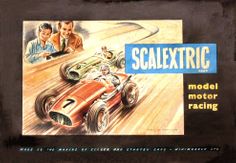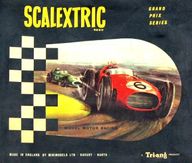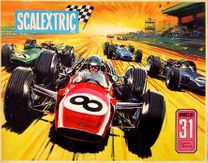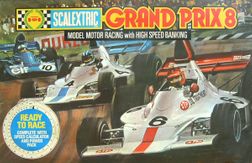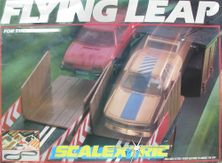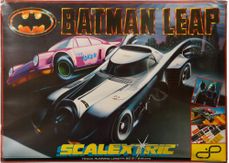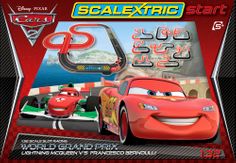The History of Scalextric
The Home of Slot Car Racing
First introduced in 1957, Scalextric has become one of the industry leaders in slot car racing. Throughout its 66-year history, Scalextric has offered exciting sets, realistic models and more. Slot cars began with basic electric tinplate cars, improving to the current highly detailed plastic models in 1960. What's more, Scalextric has been evolving with technology over the years, from the on/off power button to the innovative App-based controllers.
Many slot-car miles have been travelled since 1957, with racing enthusiasts, club members and collectors joining children and young adults alike. With new ideas and technology constantly progressing the hobby, there will be many more journeys to come.
With special thanks to Adrian Norman and The Scalextric Ultimate Guide book. Comprising of ten volumes, The Ultimate Guide covers the history and the products of an iconic British company.
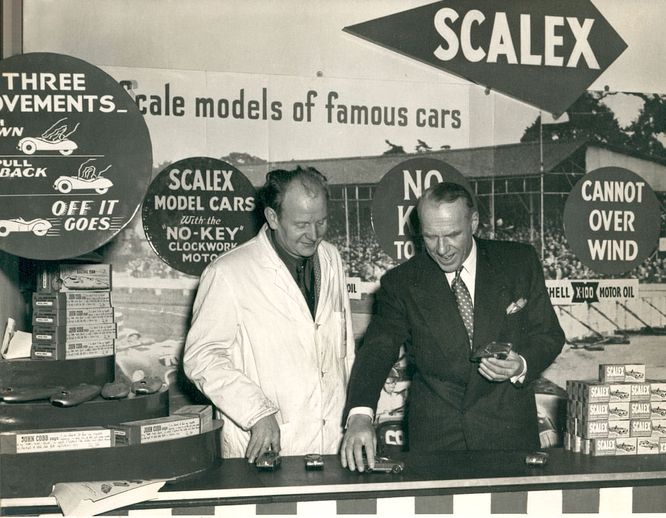
1950 - 1960
The development of Scalextric
- Scalextric was first introduced at the Harrogate International Toy Fair between the 12th and 19th January 1957.
- Minimodels Ltd manufactured tinplate models and was established ten years prior to the launch of Scalextric. The company was purchased by Line Bros (Tri-Ang Rovex) in 1958.
- Following a move to a purpose-built factory in Hampshire, testing was carried out to add an electric motor and gimbal wheel to a SCALEX tinplate car chassis on rail track, later finding slotted track more viable.
- The first Scalextric cars were the tinplate Maserati 250F and Ferrari 375 Grand Prix cars.
c. 1952 International race driver Reg Parnell trying out an Aston Martin DB2
+ Click image to view full-size
1960 - 1970
Plastic electric cars
- 1960 saw the introduction of the Scalextric catalogue, which has been issued annually ever since, with the first editions being extremely rare.
- The production of tinplate cars ceased in 1960, making way for a new range of plastic cars.
- The first plastic model was the C54 Lotus 16. The new material permitted extra detail and easier maintenance or repairs.
- Early plastic models suffered warping issues, with a resolve found by the late 1960s. Plexytrack was also introduced in 1963, replacing the traditional rubber track pieces.
c. Painted Jaguar XK120 bodies on a conveyor to the stoving ovens at the Havant works.

+ Click image to view full-size

1970 - 1980
The home of Scalextric
- Line Bros was acquired by the Dunbee-Combex Marx Group after financial troubles in 1971.
- Production of Scalextric and Tri-ang Hornby railways was transferred to Margate, creating history as the home of Scalextric and Hornby even today.
- Throughout the 70s, Scalextric explored various branding styles until a dramatic change in logo stuck in different formats right through to the twentieth century.
- Early UK set artwork was specifically commissioned by Tri-ang from Roy Nockolds, which ended in 1979. Artwork is now rendered in-house at Margate.
c. Westwood Factory, Margate, Kent UK.
+ Click image to view full-size
1980 - 1990
The start of Hornby Hobbies
- Further financial troubles arose at the start of the decade, permitting management buy-out by Wiltminster Ltd. The following year, an independent company was formed as Hornby Hobbies Ltd. This ensured the production of Scalextric and Hornby trains could continue.
- In 1986, Hornby Hobbies Ltd became a Plc, taking the company forward in a new world of computer games and electronics.
- Branding took a turn, with a stylish black appearance across set artwork and catalogues.
- Some of the key innovations were the 360-degree spin-around chassis, the flip-over mechanism and of course, the patented ‘Magnatraction’ which was introduced in 1988.
c. 1981 press release for the Porsche Le Mans set.
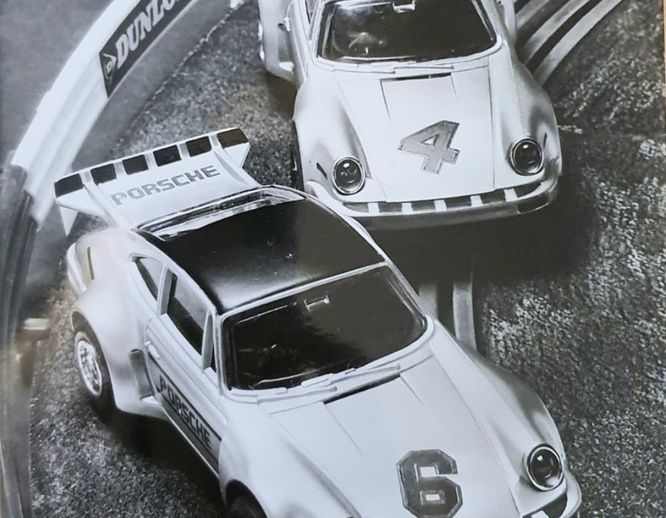
+ Click image to view full-size
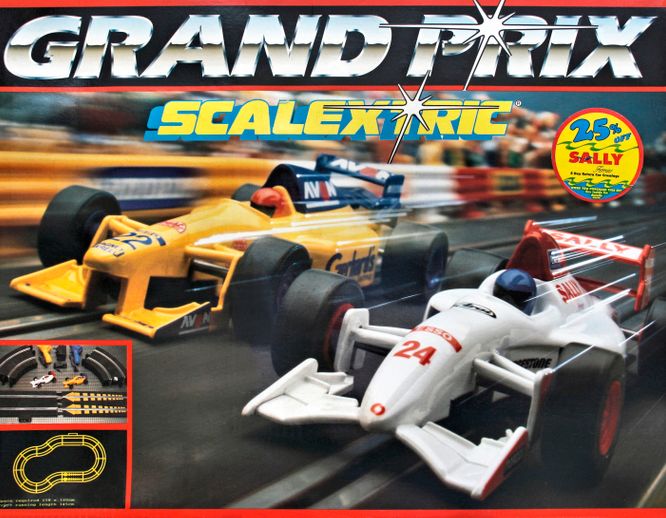
1990 - 2000
The Micro era
- The Scalextric product range was almost a 50% split between UK and Spain. In 1993, Exin-Lines Bros in Spain were purchased by TYCO Corporation which resulted in ‘SuperSlot’. Trademark restrictions meant all references of Scalextric in Spain had to be removed.
- Scalextric began working behind the scenes for a new 1:64 scale product, Micro Scalextric was introduced in 1996, with the new cars requiring a whole new track system.
- Chrome effect lettering marked the 1990s Scalextric sets, giving the brand a fresh new look.
- The inventor of Scalextric, Betram ‘Fred’ Francis died aged 78 in 1998, with the following year seeing the manufacturing outsourced from the UK to China.
c. C653 Grand Prix set from 1996.
+ Click image to view full-size
2000 - 2010
Technology of the future
- Scalextric Sport track was launched in 2000 to make it easier to assemble a racing circuit. The new track is compatible with existing 1:32 cars as well as the original track – the latter requiring an adapter piece to join the new and old designs together.
- Four years later, the 2000s was also the beginning of ‘Digital Scalextric’ – the future of slot car racing and the technology still used today.
- In 2006, Scalextric’s parent company acquired the owners of Humbrol paints and Airfix model kits. This move aided the company's position as a leading toy and model company. Two years later, Corgi model cars were also acquired.
- A Scalextric milestone took place in 2007. The brand celebrated its 50th anniversary.
c. 50th anniversary event in 2007. From left to right: Adrian Norman, Mrs Francis, John Surtees, Frank Martin, Henry Surtees.

+ Click image to view full-size

2010 - 2020
Relocation, relocation, relocation
- Between 2010 and 2020, the development of Scalextric hung in the balance with multiple changes which would alter the course of the brand. In 2014, warehousing was outsourced from the Westwood site to Hersden near Canterbury. The HQ office was also relocated to a Science Park in Sandwich, Kent.
- The year 2016 saw the closure of Hornby Hobbies’ International European subsidiary businesses and the old Westwood factory was sold.
- The current CEO Lyndon Davies was appointed in 2017 and the following year, Hornby Hobbies moved back to rent the old HQ office building at Westwood, joining the Hornby Visitor Centre which had remained after the move in 2015.
c. James May at the Scalextric Margate HQ re-opening in February 2019.
+ Click image to view full-size
2020 - Present
Full throttle nostalgia
- With a pandemic on the rise in 2020, a new normal consisted of social distancing, staying at home, which meant more time to pick up old hobbies.
- With a nation inspired to rediscover childhood hobbies, Scalextric sets found their way out of the loft and slot car fans experienced true nostalgia, passing their passion down the generations.
- Spark Plug was introduced in 2020 - a wireless dongle allowing players to race their cars from their smart devices. Since then several updates have become available to allow for versus mode and larger family play.
- Scalextric has been releasing new and exciting products to reignite the slot car passion and offer a gateway into the hobby for the new generation of young racing enthusiasts.
c. Vintage Scalextric set boxes, entered as part of the Scalextric dustiest set competition in April 2020.
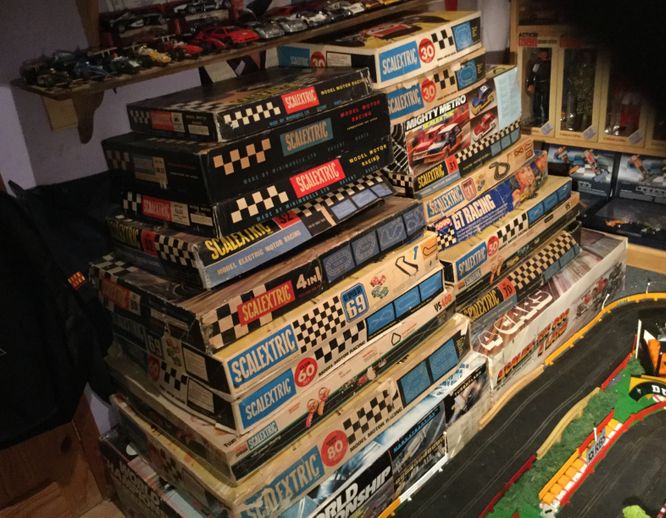
+ Click image to view full-size
Browse the range
Don't hesitate to become part of our history, discover the full Scalextric range today.
Shop now









